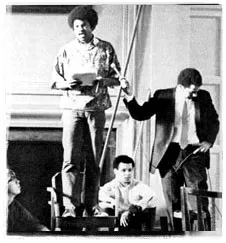1969 Black Student Protest Movement

In 1969, Swarthmore College’s black protest movement, spearheaded by students in the Swarthmore Afro-American Student Society (SASS) sat in the Admissions Office demanding increased black enrollment. Their actions, supported by the majority of black students including those who were not formally a part of SASS, came in response to dwindling numbers of black students and to the insensitivity and lack of administrative support for black students on campus.
The sit-in lasted eight days, and the following year saw a large increase in the number of black students at the college. That year (1970), students pushed for and received a Black Cultural Center. The College hired black American faculty members for the first time and hired a black admissions dean and a black counselor. Students worked through the college processes to establish a Black Studies program and led their own courses while they fought for formalized curricula. The actions they took changed the college by making the curriculum, political life, and culture of Swarthmore more relevant for its black students. The students were the catalyst for a needed re-imagining and expansion of the meaning of Swarthmore.
In 2014, the College's sesquicentennial year, Professor of History Allison Dorsey led a research seminar, Black Liberation 1969: Black Studies in History Theory and Praxis, and designed a digital archive of the civil rights movement at Swarthmore in support of the seminar. The Black Liberation 1969 archive includes nearly 1,000 documents - collected from College archives, interviews, personal collections, and newspaper records - showing an array of voices and viewpoints from this time. The digital archive also includes a timeline that highlights the key events in the experience of black students at Swarthmore from 1964-1972.
In a related interview, Dorsey said the archive "stands as a bulwark against the College losing or forgetting the story of black student activism, which significantly improved Swarthmore for the better."



